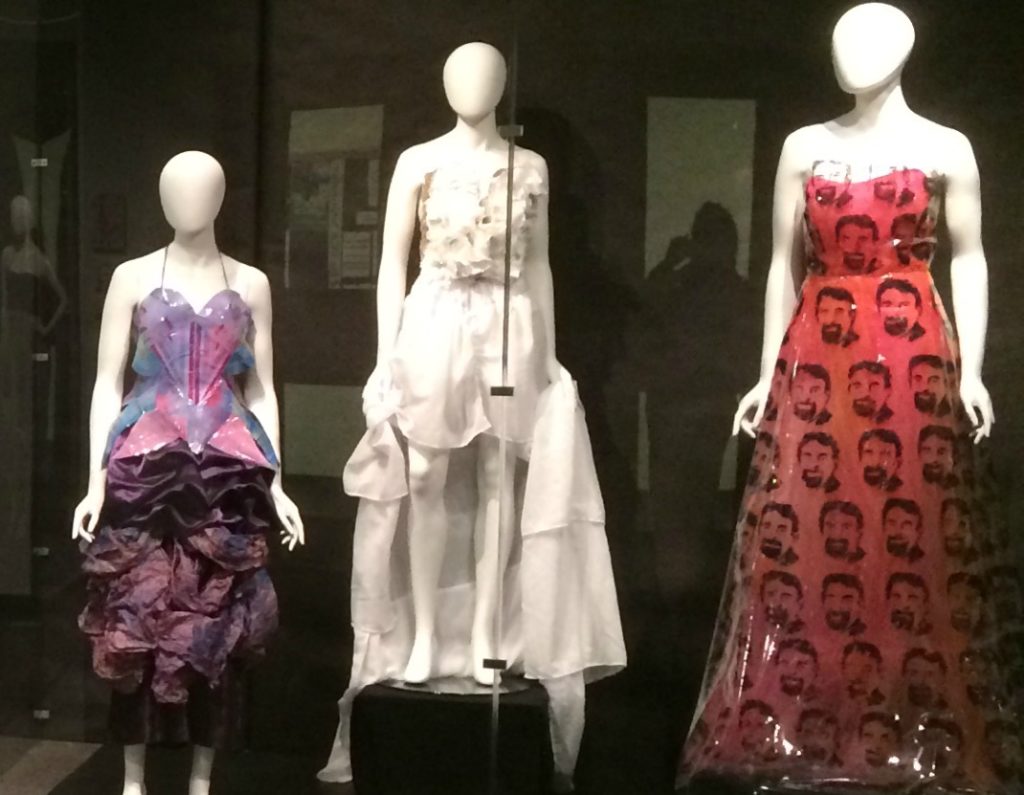
Story by Doreen Beard
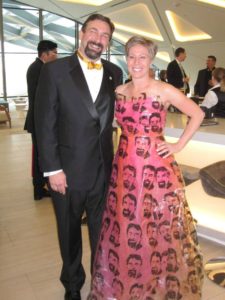
CSU President Tony Frank is known by students for his sense of humor – a characteristic that inspired a ball gown that is now entering the Avenir Museum of Design and Merchandising’s permanent collection.
Frank’s smiling face and beard were incorporated as design elements for a formal ball gown made of recycled materials by CSU student Nina Mascheroni (’17) for an academic entrant in the Fall 2014 Recycled Fashion Show, produced by the CSU student chapter of Fashion Group International.
Pop Art inspiration
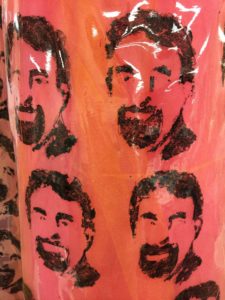 “I wanted to create a garment that played with the traditional symbolism of the Pop Art movement, yet keep it contemporary,” Mascheroni said. “I chose to do a screen print of Tony Frank, CSU president, because of his iconic facial hair. I created a stencil of Tony Frank with spray adhesive, Sharpies, cardboard, and an Exacto knife. I stenciled the vinyl [shower curtain] with acrylic paint and machine sewed the vinyl together. The base is made of pink cotton adorned with pink and orange tulle. The zipper was hand sewn. I wanted to create a garment that played with light, opacity and color.”
“I wanted to create a garment that played with the traditional symbolism of the Pop Art movement, yet keep it contemporary,” Mascheroni said. “I chose to do a screen print of Tony Frank, CSU president, because of his iconic facial hair. I created a stencil of Tony Frank with spray adhesive, Sharpies, cardboard, and an Exacto knife. I stenciled the vinyl [shower curtain] with acrylic paint and machine sewed the vinyl together. The base is made of pink cotton adorned with pink and orange tulle. The zipper was hand sewn. I wanted to create a garment that played with light, opacity and color.”
Little did Mascheroni know the adventure that awaited her whimsical, yet academic, creation – formally titled “Tony Frank!” – over the next three years. After the recycled-materials dress was worn in the Fall 2014 Recycled Fashion Show, and then exhibited in the Avenir Museum during Fall 2015, Mascheroni donated the ball gown to the 2016 CSU Ram Good Time Auction, which benefits the scholarship fund for CSU student-athletes. The successful bidder, alumna Traci McBee Rowe (’03) wore the gown to the 2016 CSU Green and Gold Gala in Denver just long enough to be photographed with Frank (remember, she was wearing vinyl!), and then arranged to donate this unique piece of institutionally inspired apparel to the Avenir Museum.
Collection considerations
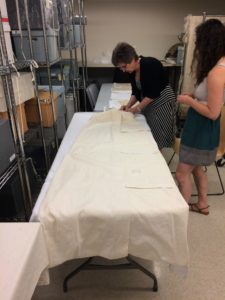 However, “Tony Frank!” required some special accommodation to enter a museum collection, where strategic decisions about conservation and preservation are paramount. Specifically, the Avenir Museum is responsible for protecting this unique ball gown for its own integrity – as well as the other garments in the collection – from any harm of toxins or gases emitted from the unusual materials of this particular gown. Vinyl and tulle have limited longevity, and the acrylic paint of the repetitive screen print adhered to the inner layer of the vinyl surface of the ball gown adds yet another layer of complexity to storage considerations. Since we effectively did not have any formal Material Safety Data Sheet-type information on its materials’ composition, “Tony Frank!” needed to be accessible, yet purposefully and gently isolated while we investigate further.
However, “Tony Frank!” required some special accommodation to enter a museum collection, where strategic decisions about conservation and preservation are paramount. Specifically, the Avenir Museum is responsible for protecting this unique ball gown for its own integrity – as well as the other garments in the collection – from any harm of toxins or gases emitted from the unusual materials of this particular gown. Vinyl and tulle have limited longevity, and the acrylic paint of the repetitive screen print adhered to the inner layer of the vinyl surface of the ball gown adds yet another layer of complexity to storage considerations. Since we effectively did not have any formal Material Safety Data Sheet-type information on its materials’ composition, “Tony Frank!” needed to be accessible, yet purposefully and gently isolated while we investigate further.
Major considerations included:
- How to construct a garment bag so the ball gown can “breathe?”
- How to prevent the paint on the shower curtain from further flaking?
- Any garment bag devised must permit easy removal of the ball gown, since it cannot be folded, cramped, or scraped in any way upon removal from the bag, lest damage occur.
- The overall garment bag could not dominate a space in the collection.
Custom garment bag
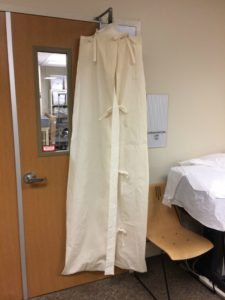
Mindful of these parameters, Avenir Museum volunteer and expert sewer Mary Biggers designed and constructed a custom garment bag of 100 percent cotton muslin fabric, prewashed to remove any fabric finish chemicals, dirt and other contaminants. She avoided typical closure devices such as zippers, snaps or hooks in favor of ties made of the same muslin fabric.
The final garment storage bag is an A-line shaped piece with opened shoulders and two sets of ties to hold up the long bag on a padded hanger. The top of the garment bag is open and secured by ties on each side of the hanger. The front of the bag also has sets of ties for easy access; the bottom of the bag is closed. The garment bag can be completely opened so that it is free to lift “Tony Frank!” out without folding or causing further abrasive damage to the screen-printed acrylic print repeat of the design.
For future research purposes, Biggers sewed a piece of test fabric into the garment bag for anticipated testing of toxins, or for additional research when the Avenir Museum arranges further inquiry with our textiles science colleagues in the Department of Design and Merchandising and their associates in the chemistry and engineering arena.
In the meantime, a very unique object of institutional apparel history connects a student, an alumna donor, a community museum volunteer, and a university president – the Avenir Museum is indebted to each one of them for their contribution to “Tony Frank!”
Working in technical design
Designer Nina Mascheroni (’17) received wide recognition for her iconic ball gown’s creation back in 2014, and went on to intern in product development with Tanya Taylor in New York City . Following graduation from CSU (B.S., apparel and merchandising, with a concentration in apparel design and production), Mascheroni is now working in technical design at Jonathan Simkhai, also in NYC.
The Avenir Museum is in the Department of Design and Merchandising, part of CSU’s College of Health and Human Sciences.